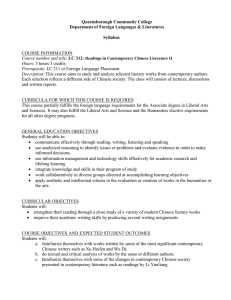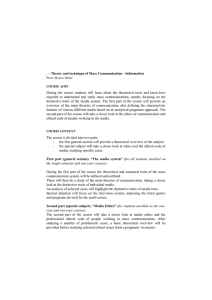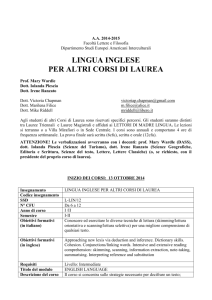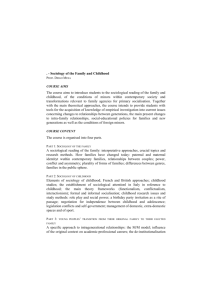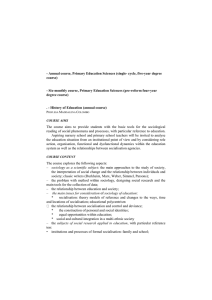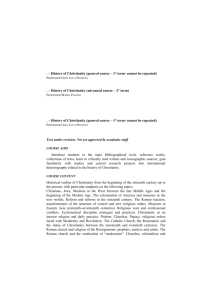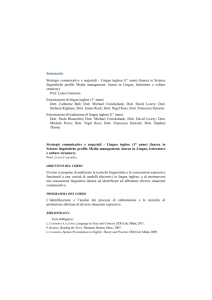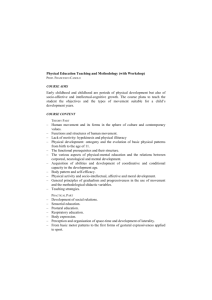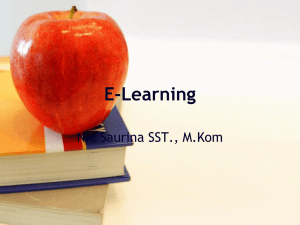History of Contemporary Art
advertisement
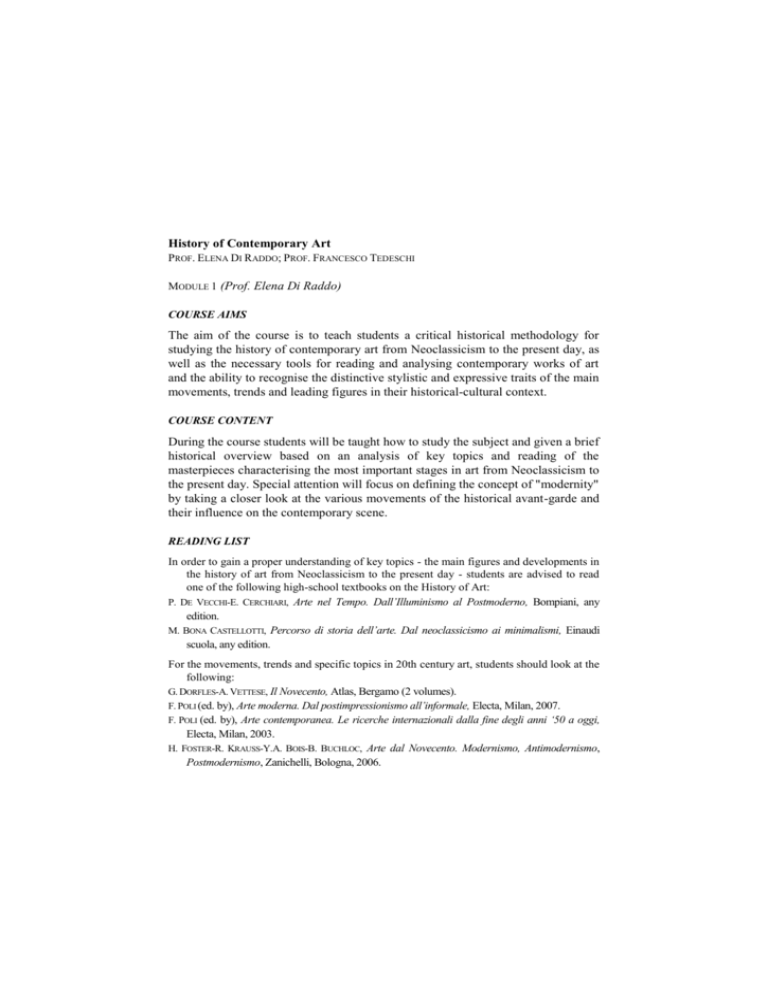
History of Contemporary Art PROF. ELENA DI RADDO; PROF. FRANCESCO TEDESCHI MODULE 1 (Prof. Elena Di Raddo) COURSE AIMS The aim of the course is to teach students a critical historical methodology for studying the history of contemporary art from Neoclassicism to the present day, as well as the necessary tools for reading and analysing contemporary works of art and the ability to recognise the distinctive stylistic and expressive traits of the main movements, trends and leading figures in their historical-cultural context. COURSE CONTENT During the course students will be taught how to study the subject and given a brief historical overview based on an analysis of key topics and reading of the masterpieces characterising the most important stages in art from Neoclassicism to the present day. Special attention will focus on defining the concept of "modernity" by taking a closer look at the various movements of the historical avant-garde and their influence on the contemporary scene. READING LIST In order to gain a proper understanding of key topics - the main figures and developments in the history of art from Neoclassicism to the present day - students are advised to read one of the following high-school textbooks on the History of Art: P. DE VECCHI-E. CERCHIARI, Arte nel Tempo. Dall’Illuminismo al Postmoderno, Bompiani, any edition. M. BONA CASTELLOTTI, Percorso di storia dell’arte. Dal neoclassicismo ai minimalismi, Einaudi scuola, any edition. For the movements, trends and specific topics in 20th century art, students should look at the following: G. DORFLES-A. VETTESE, Il Novecento, Atlas, Bergamo (2 volumes). F. POLI (ed. by), Arte moderna. Dal postimpressionismo all’informale, Electa, Milan, 2007. F. POLI (ed. by), Arte contemporanea. Le ricerche internazionali dalla fine degli anni ‘50 a oggi, Electa, Milan, 2003. H. FOSTER-R. KRAUSS-Y.A. BOIS-B. BUCHLOC, Arte dal Novecento. Modernismo, Antimodernismo, Postmodernismo, Zanichelli, Bologna, 2006. The examination syllabus will be completed by an in-depth study of a chosen topic to be prepared by reading one of the books listed by the lecturer that will be posted on the Institute's notice board, webpage and Blackboard website. Students unable to attend lectures will read any two of the books. TEACHING METHOD Lecturers with visual aids. Use of the blackboard online platform as a teaching aid. Supervised visits to exhibitions and museums. There will also be exercises throughout the year, which are particularly recommended for those students who had never previously studied the subject. ASSESSMENT METHOD To show they have achieved the course targets, students will sit an examination based on recognising and analysing one or more works of art and setting them in their context. This test (based on study from the course book) may take the form of a written examination planned to be held at the end of the first semester and end of the second semester and completed by an oral examination (on the topic for further study) during the official examination sessions. Both parts (course book and further study) may also be taken as oral tests during official examination sessions, either on the same date or different dates. NOTES Further information can be found on the lecturer's webpage at http://docenti.unicatt.it/web/searchByName.do?language=ENG, or on the Faculty notice board. MODULE 2 (Prof. Francesco Tedeschi) COURSE AIMS Students will learn about the stylistic traits and poetic foundations of contemporary artistic experimentation. They will also be shown a methodological and critical approach to the history of contemporary art, setting art events within the cultural context in which they first emerged based on an interdisciplinary viewpoint. COURSE CONTENT The subject, aimed at students on the second-level degree course in Modern Philology, will be: Conceptual art in Italy. The subject will be studied bearing in mind critical-historical readings and analyses of works by Italian artists that helped transform art along conceptual lines in the 60s-70s. The special subject will look at artists like Piero Manzoni, Giulio Paolini, Vincenzo Agnetti, Gianfranco Baruchello, Michelangelo Pistoletto, Emilio Isgrò, Alighiero Boetti, Franco Vaccari, Carlo Alfano. Critical debate during the periods in question will also be taken into consideration. The second semester course, aimed at students studying for second-level degrees as well as students on first-level degree courses taking the one-year examination, will focus on the subject: Vite parallele: Pablo Picasso e Giorgio de Chirico. The personalities and works of these two artists will be studied in terms of their similarities and relations while bearing in mind their distinctive traits. READING LIST For the first semester F. MENNA, La linea analitica dell’arte moderna, Le figure e le icone, Einaudi, Turin, 1975 (also later editions). P. OSBORNE, Arte concettuale, Phaidon Press, London-New York, 2006. M.T. ROBERTO, Arte concettuale and G. ZANCHETTI, Poesia visiva, in F. POLI, Arte contemporanea, Electa, Milan, 2003. Suggestions for further reading will be referred to and provided at lectures, including those about the individual artists being studied. For the second semester M. CALVESI (edited by), L’opera completa di de Chirico: 1908-1924, “Classici dell’Arte”, Rizzoli, Milan, 1984. L’opera completa di Picasso cubista, presentazione di F. Russoli, apparati di F. Minervino, “Classici dell’arte”, Rizzoli, Milano, 1972. E. GRAZIOLI (edited by), Pablo Picasso, “Riga 12”, Marcos y Marcos, Milan, 1996. Picasso 1917-1924: il viaggio in Italia, exhibition catalogue, edited by J. Clair, Palazzo Grassi, Venice, 1998 (Bompiani, Milan, 1998). Metafisica, exhibition catalogue, edited by E. Coen, Scuderie del Quirinale, Rome, 27th September 2003 – 6th January 2004 (Electa, Milan, 2003). De Chirico, exhibition catalogue, edited by P. Baldacci-G. Roos, Palazzo Zabarella, Padua, 2007 (Marsilio, Venice, 2007). Suggestions for further reading on specific topics and subjects studied at lectures will be given at lectures and posted on the lecturer’s webpage at the end of the course. TEACHING METHOD The course will be taught in lectures with slideshows and analyses of works by the artists being studied, which will then be uploaded on the Blackboard website. There will also be educational trips to exhibitions and museums carefully geared to the topics being studied. ASSESSMENT METHOD Assessment will be based on an oral examination held during the official examinations period. NOTES There will also be a workshop and seminar allowing further study on the topics in question, mainly aimed at students on second-level degree course. Further information can be found on the lecturer's webpage at http://docenti.unicatt.it/web/searchByName.do?language=ENG, or on the Faculty notice board.

